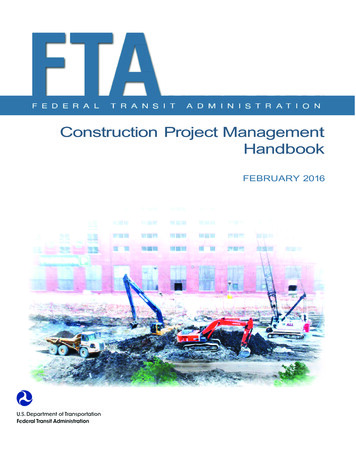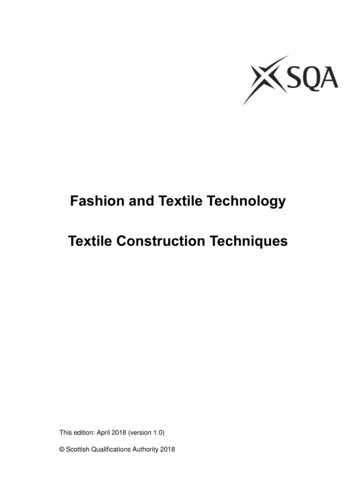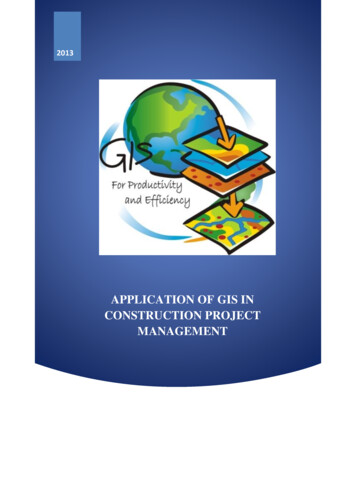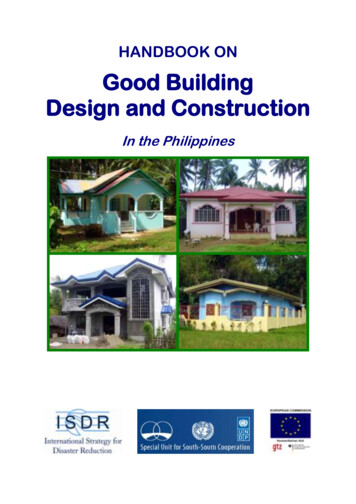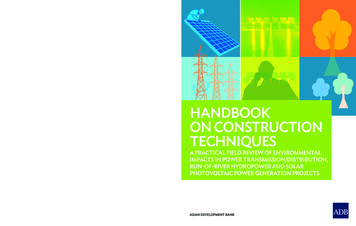
Transcription
Handbook on Construction TechniquesA Practical Field Review of Environmental Impacts in Power Transmission/Distribution, Run-of-River Hydropowerand Solar Photovoltaic Power Generation ProjectsThe report highlights a broad spectrum of environmental impacts triggered due to construction, operation,and maintenance and their mitigation for four sectors: (i) power transmission, (ii) distribution,(iii) run-of-river hydropower, and (iv) solar photovoltaic generation projects for dissemination amongAsian Development Bank specialists working in the energy sector and environment fields.About the Asian Development BankADB’s vision is an Asia and Pacific region free of poverty. Its mission is to help its developing membercountries reduce poverty and improve the quality of life of their people. Despite the region’s many successes,it remains home to the majority of the world’s poor. ADB is committed to reducing poverty through inclusiveeconomic growth, environmentally sustainable growth, and regional integration.Based in Manila, ADB is owned by 67 members, including 48 from the region. Its main instruments forhelping its developing member countries are policy dialogue, loans, equity investments, guarantees, grants,and technical assistance.Handbookon ConstructionTechniquesA Practical Field Review of EnvironmentalImpacts in Power Transmission/Distribution,Run-of-river Hydropower and SolarPhotovoltaic Power Generation ProjectsAsian Development Bank6 ADB Avenue, Mandaluyong City1550 Metro Manila, Philippineswww.adb.orgASIAN DEVELOPMENT BANK
HANDBOOKON CONSTRUCTIONTECHNIQUESA PRACTICAL FIELD REVIEW OF ENVIRONMENTALIMPACTS IN POWER TRANSMISSION/DISTRIBUTION,RUN-OF-RIVER HYDROPOWER AND SOLARPHOTOVOLTAIC POWER GENERATION PROJECTSRajat Jain and Shotaro SasakiSeptember 2015ASIAN DEVELOPMENT BANKi
Creative Commons Attribution 3.0 IGO license (CC BY 3.0 IGO) 2015 Asian Development Bank6 ADB Avenue, Mandaluyong City, 1550 Metro Manila, PhilippinesTel 63 2 632 4444; Fax 63 2 636 2444www.adb.org; openaccess.adb.orgSome rights reserved. Published in 2015.Printed in the Philippines.ISBN 978-92-9257-123-8 (Print), 978-92-9257-124-5 (e-ISBN)Publication Stock No. TIM157535-2Cataloging-In-Publication DataAsian Development Bank.Handbook on construction techniques—A practical field review of environmental impacts in powertransmission/distribution, run-of-river hydropower and solar photovoltaic power generation projects.Mandaluyong City, Philippines: Asian Development Bank, 2015.1. Environment.2. Power.3. Construction.I. Asian Development Bank.The views expressed in this publication are those of the authors and do not necessarily reflect the views and policiesof the Asian Development Bank (ADB) or its Board of Governors or the governments they represent.ADB does not guarantee the accuracy of the data included in this publication and accepts no responsibility for anyconsequence of their use. The mention of specific companies or products of manufacturers does not imply that theyare endorsed or recommended by ADB in preference to others of a similar nature that are not mentioned.By making any designation of or reference to a particular territory or geographic area, or by using the term “country”in this document, ADB does not intend to make any judgments as to the legal or other status of any territory or area.This work is available under the Creative Commons Attribution 3.0 IGO license (CC BY 3.0 o/. By using the content of this publication, you agreeto be bound by the terms of said license as well as the Terms of Use of the ADB Open Access Repositoryat openaccess.adb.org/termsofuseThis CC license does not apply to non-ADB copyright materials in this publication. If the material is attributedto another source, please contact the copyright owner or publisher of that source for permission to reproduce it.ADB cannot be held liable for any claims that arise as a result of your use of the material.Attribution—In acknowledging ADB as the source, please be sure to include all of the following information:Author. Year of publication. Title of the material. Asian Development Bank [and/or Publisher].https://openaccess.adb.org. Available under a CC BY 3.0 IGO license.Translations—Any translations you create should carry the following disclaimer:Originally published by the Asian Development Bank in English under the title [title] [Year of publication]Asian Development Bank. All rights reserved. The quality of this translation and its coherence with the original textis the sole responsibility of the [translator]. The English original of this work is the only official version.Adaptations—Any adaptations you create should carry the following disclaimer:This is an adaptation of an original Work Asian Development Bank 2014. The views expressed here arethose of the authors and do not necessarily reflect the views and policies of ADB or its Board of Governors or thegovernments they represent. ADB does not endorse this work or guarantee the accuracy of the data included in thispublication and accepts no responsibility for any consequence of their use.Please contact OARsupport@adb.org or publications@adb.org if you have questions or comments with respectto content, or if you wish to obtain copyright permission for your intended use that does not fall within these terms,or for permission to use the ADB logo.Note: In this publication, “ ” refers to US dollars.Photos: All are ADB.
ContentsTables and ts and MeasuresviiiI.Introduction1II. Construction Techniques and Methodology Used by Project Proponents4III Stages of Power Transmission and Distribution Lines Project Design, Construction andRelated Environmental Impacts and Mitigation8A. Transmission LinesDesign CriteriaConstruction Practice, their Environmental Impacts, Mitigation and Work processB. Distribution LinesDesign CriteriaConstruction Practice, their Environmental Impacts, Mitigation and Work process111112363637IV. Stages of Power Substation Project Design, Construction and Related EnvironmentalImpacts and Mitigation45A. Transmission/Distribution SubstationsDesign CriteriaConstruction Practice, their Environmental Impacts, Mitigation and Work ProcessB. Distribution Transformers (below 33 kV)Construction Practice, their Environmental Impacts, Mitigation and Work process4545478181Stages of Run-of-River Hydropower Project Design, Construction and RelatedEnvironmental Impacts and Mitigation85A. Run-of-River (ROR) Hydropower ProjectDesign CriteriaConstruction Practice, their Environmental Impacts, Mitigation and Work Process878787VI. Stages of Solar Photovoltaic (SPV) Power Generation Project Design, Constructionand Related Environmental Impacts and Mitigation134A. Solar Photovoltaic (SPV) Generation PlantDesign CriteriaConstruction Practice, their Environmental Impacts, Mitigation and Work Process134134135V.iii
VII. Construction Related Environment Due Diligence Triggers and General CumulativeImpactsA. General Cumulative Impacts During Construction, Operations andMaintenance PhaseB. Monitoring During Construction, Operations and Maintenance PhasesC. Design of O&M Process after Completion of ConstructionD. Recommended follow-up Activities for Better Environmental Managementafter CommissioningVIII. Key lessons in project implementation for designated sector power projectsA. Environment Related ImpactsB. Some Non-Environmental Impactsiv163163165167165169169174IX. Conclusions176References177Glossary of terms used178Handbook on Construction Techniques
Tables and FiguresTables1Illustrative Differences in Construction Practices followed52Transmission Lines- Stepwise Project Activities, Construction Impacts, Mitigation,and Work Process Involved153Distribution Lines - Stepwise Project Activities, Construction Impacts, Mitigation and WorkProcess Involved404Type of Power Substations485Transmission/Distribution Substation-Stepwise Project Activities, Construction Impacts,Mitigation and Work Process Involved516Distribution Transformer Construction Activity837Hydropower Project: Stepwise Project Activities, Construction Impacts, Mitigationand Work Process Involved928Small Hydropower Projects Construction Activity1319Solar Power Project - Stepwise Project Activities, Construction Impacts, Mitigationand Work Process Involved13810 General Cumulative Impacts During Construction, Operations and Maintenance16311Project Monitoring Required During Construction, Operations and Maintenance16612 Key Lessons in Project Implementation in Designated Power Sectors16913Non-Environmental Activities that Adversely Impacts Local Area174Figures12347Target Power Sector Projects for the studySchematic Diagram of the Transmission/Distribution SystemProcess Flow Chart for Construction of Transmission LinesProcess Flow Chart for Construction of Distribution LineProcess Flow Chart for Construction of Distribution Transformer311143882v
AbstractThe report highlights a broad spectrum of environmental impacts triggered due to construction,operations and maintenance and their mitigation for four sectors - power transmission/distribution, runof-river hydropower and solar photovoltaic generation projects (hereby known as “designated sectors” inthe report). These include impacts on physical resources, environmental resources, ecological resourcesand the human environment in the project area.This report discusses construction related project aspects and presents an inventory of methodologiesused, their environmental impacts, mitigation and management issues for dissemination among AsianDevelopment Bank’s (ADB) specialists who are working in the energy sector and environment fields, areinvolved in appraisal, day-to-day due-diligence for project approvals, progress monitoring and impactevaluation.Section I introduces the relationships between the designated sectors while Section II discusses the typeof construction techniques used for designated power projects vs. the alternative methods available andthe reasons for using them. Section III-VI brings forth several instances of technical design, construction,commissioning including discussions on the impacts noted at each stage and mitigation actions proposedfor each of the impacts noticed for each designated power sector. Section VII reviews the triggers forenvironmental due-diligence and general cumulative impacts for designated power projects at theirvarious stages of construction as well as discusses the monitoring needs for each type of designatedpower project. Section VIII highlights few experiences of project implementation in the designated powersector whereas Section IX concludes the report by summarizing the key findings.The glossary of terms used along with common explanations, and the references section containing listsof sources of information obtained from project documents and other secondary sources. The picturesattached in the report are cross referenced with the activity, its impact and/or mitigation measure. Thesite photographs have been taken by the author at various project sites.vi
AuthorsShotaro Sasaki is a Senior Safeguards Specialist at Asian Development Bank (ADB). Before joining intoADB, He had 12 years’ experience as an International energy/ environment problem mitigation professionalas an electric power engineer specialized in climate change mitigation through renewable energypromotion, cleaner and environmentally sound technologies, and energy development in both publicand private sectors. He has three Master Degrees regarding broad range of environmental issues and iscurrently involved in a PhD program working on the topic related with climate change and development.He has worked extensively in developing countries such as Afghanistan, Bangladesh, Bhutan, the People’sRepublic of China, India, Indonesia, Kazakhstan, Maldives, Myanmar, Nepal, Pakistan, Sri Lanka, Thailand,and Uzbekistan.Rajat Jain is Director of Deneb Consultants Private Limited and has been working as a power engineeringand environmental assessment consultant extensively in the South Asian region for Asian DevelopmentBank (ADB). Besides, he also owned and operated an engineering firm for execution of turnkey projectsin the area of power transmission in India. Prior to this, he was the Mission Environment Officer for UnitedStates Agency for International Development, India (USAID/India). He was head of project for RegionalUrban Environment project for India, Nepal, Bangladesh, Sri Lanka for USAID/India as well as the Indiahead for Coal Mine Health and Safety project for United States Department of Labor. He has an MBAfrom USA and a Bachelors of Engineering from India.vii
AbbreviationsADBCSPCSRDC or –Asian Development BankConcentrated Solar PowerCorporate Social ResponsibilityDouble CircuitDetailed Project ReportExtra High VoltageEnvironmental Impact AssessmentEnvironmental Monitoring PlanEnvironmental Management PlanEngineering Procurement and ConstructionGreen House GasGrievance Redress MechanismHigh TensionHeating Ventilation and Air conditioningHigh Voltage Distribution SystemInitial Environmental ExaminationLow TensionMean Sea LevelPoly Chlorinated BiphenylProject Implementation ConsultantProject ProponentOperations and MaintenanceRight of WayRun-of-RiverRoof Top SolarSolar PhotovoltaicSulphur HexafluorideWeights and MeasuresviiiHa. (hectare)–10,000 sq m 2.47105 Acreskm (kilometer)–1,000 meterskV–kilovolt (1,000 volts)kW–kilowatt (1,000 watts)MW–Mega WattHandbook on Construction Techniques
I Introduction1. A power engineer’s view on the role of an environmental expert in power sector development has notalways been unanimous. For instance, questions are often raised over the environmental concerns thatmay lead to adverse impact on nature vis-a-vis the consequential additional costs to the proje
9 Solar Power Project - Stepwise Project Activities, Construction Impacts, Mitigation and Work Process Involved 138 10 General Cumulative Impacts During Construction, Operations and Maintenance 163 11 Project Monitoring Required During Construction, Operations and Maintenance 166 12 Key Lessons in Project Implementation in Designated Power Sectors 169 13 Non-Environmental Activities that .

